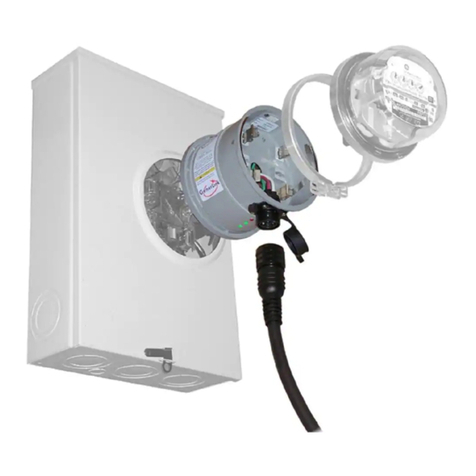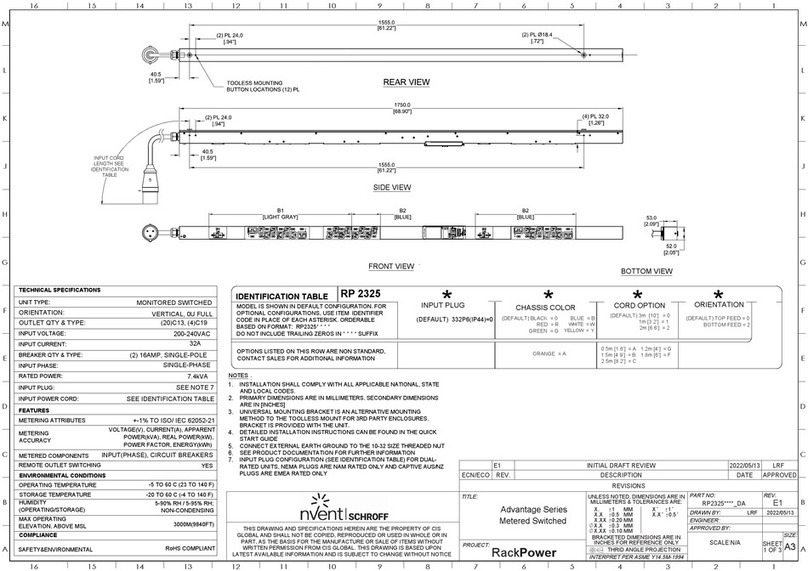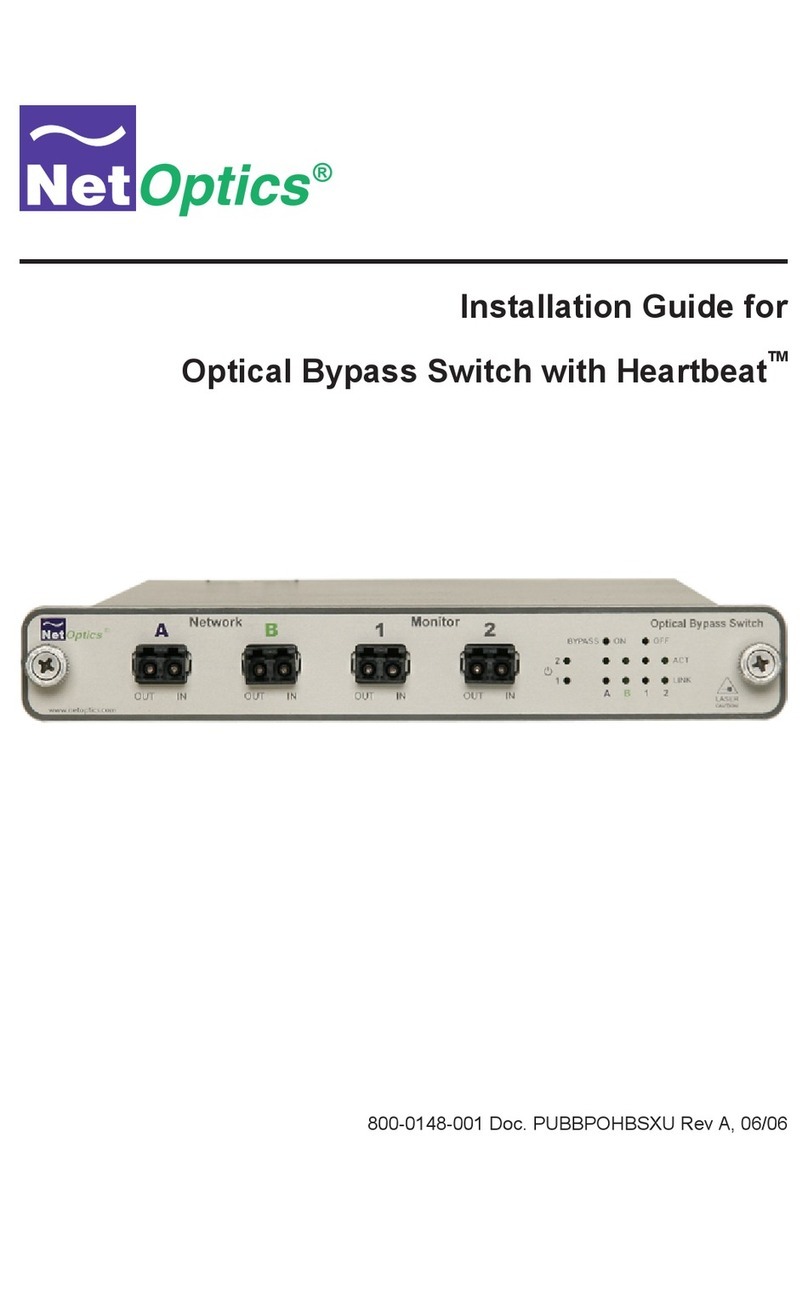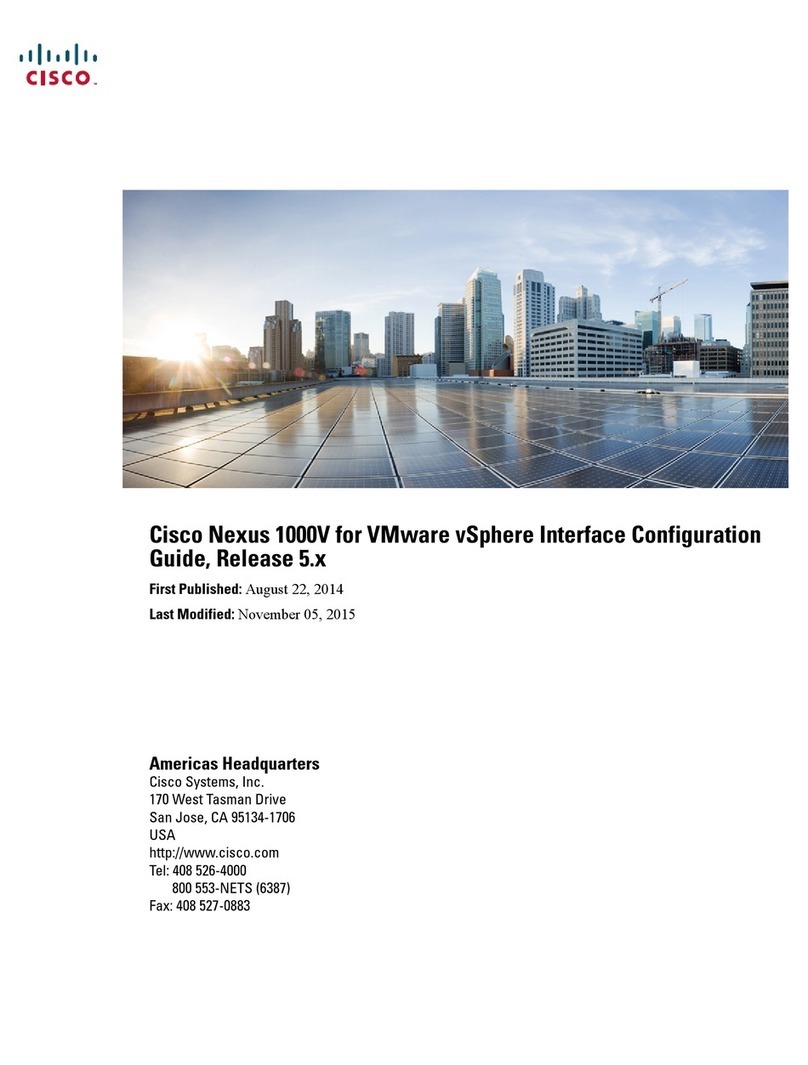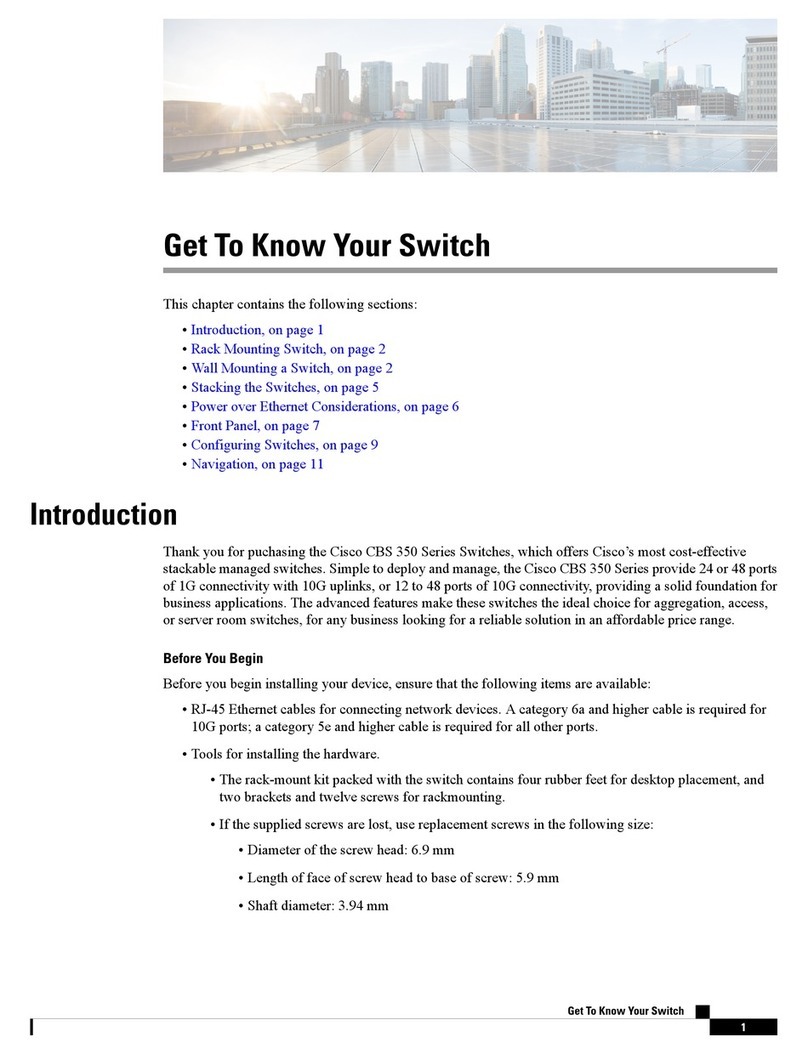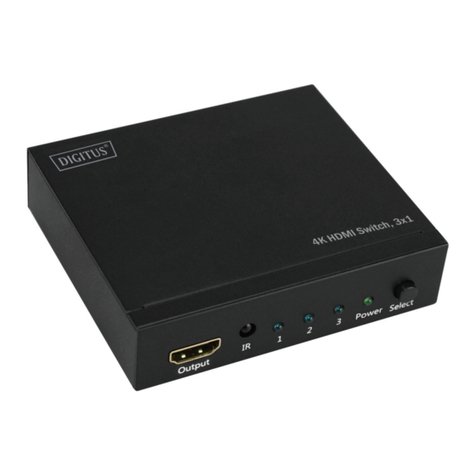GenerLink MA23-N User manual

Operating Manual
Operating Manual
www.generlink.com
MA23-N (unit without whole house surge suppression)
MA23-S (unit with whole house surge suppression)
MA24-N (unit without whole house surge suppression)
MA24-S (unit with whole house surge suppression)
Operating Manual
GenerLink™
225 Arnold Road
Lawrenceville, GA 30044
www.generlink.com
OPER-MA23/24-N/S
5.1.19
Please refer
to page 22
for GenerLink testing,
while utility power
is present.

W
Warranty and Service Information
arranty and Service Information
GenerLink™ Manufacturers Limited Warranty
Global Power Products (GPP) warrants GenerLink™for a period of two (2) years unconditional
replacement, plus an additional five (5) year manufacturers warranty after delivery of goods,
where specified that the goods are, under normal use and service, free from defects in materials,
and workmanship. No other warranties or representations, whether written or oral, shall be
binding upon Global Power Products. If any unit provided by Global Power Products does not
comply with any of the expressed warranties set forth above and customer provides Global Power
Products notice of such noncompliance within the seven (7) year warranty period, Global Power
Products shall at its discretion repair or replace the nonconforming unit after receipt of the
nonconforming unit for its inspection. Global Power Products’ sole liability to customer for goods
not conforming to any of the express warranties is limited to repair or replacement of such units.
Warranty on the repaired unit or any component thereof is limited to the balance of the original
warranty period.
Surge Protection Manufacturers Limited Warranty
Fifteen Year Product Coverage
GPP will repair or replace any Surge Protection Device that is defective in material or
workmanship or is damaged by an electrical surge (including those caused by lightning) for a
period of fifteen (15) years from the date of installation or fifteen years and six (6) months from
the date of manufacture, whichever comes first. Maximum coverage is $1,000 per
appliance, $10,000 per residence.
A “White Goods Appliance” is defined as a washer, dryer, stove, refrigerator, freezer, HVAC unit,
dishwasher or garbage disposal. Coverage is secondary to any applicable product warranties,
service contracts and insurance policies.
This coverage applies to the end-user at the residence where the product is installed and is the
exclusive remedy under this warranty, whether based on contract, tort, including negligence or
otherwise. GPP reserves the right to audit damage, site and/or cost of repairs and may require a
notarized proof of loss. Claims must be made within 30 days of damage. This warranty does not
cover damage associated with sustained overvoltages, vandalism, theft, normal wear and tear,
obsolescence, abuse, unauthorized modification, misuse, improper installation, or catastrophic
events. Except as expressed previously in this warranty, GPP disclaims liability of any incidental,
indirect, special, or consequential damage arising out of the sale, lease, or use of any GPP product
(including without limitation, lost business profits, loss of data and all freight, mileage, travel
time, and insurance charges associated with the warranty coverage claims). Some states do not
allow the exclusion or limitation of incidental or consequential damages, so the above does not
apply to you. This warranty gives you specific legal rights and you may have other rights which
vary from state to state. This warranty is valid in the United States and Canada only.
Surge Protection Warranty Assistance: Call 1-800-886-3837
ii
Transfer Switch: Used in conjunction with a sub panel. Device installed by a
licensed electrician designed to allow interconnection of a portable generator with
limited appliance availability.
Utility’s Electric Distribution System: A network of power lines and associated
equipment used to transmit and distribute electricity over a geographic area.
Voltage: Electrical potential or force that causes current to flow through a conductor.
Watt: A unit that measures the amount of electrical power. watts = volts x amps
26
Important Installation Information
Important Installation Information
You MUST have this information should the unit need repair or
replacement. Please complete the information and keep this
information for future reference.
Installation Date:
_________________________________________________________________
Company Name:
_________________________________________________________________
Address:_________________________________________________________
_________________________________________________________________
Phone Number:
_________________________________________________________________
Installer Company Name:
_________________________________________________________________
GenerLink Serial Number:
_________________________________________________________________
GenerLink™ unit shall not be removed or uninstalled by anyone other than an Approved
Installer. If the GenerLink™ unit requires inspection, removal, repair, or replacement,
immediately contact the Approved Installer or a licensed electrician to request that the
GenerLink™ unit be removed. Once the GenerLink™ unit is removed, contact GenerLink™ at
225 Arnold Road, Lawrenceville, GA 30044, or call at 1.800.886.3837 to receive instructions on
how to have the GenerLink™ unit repaired and/or replaced.
T
Terms and Conditions of Usage
erms and Conditions of Usage
TERMS AND CONDITIONS. Upon breaking the seal attached to the installed GenerLink™, you
expressly agree that usage is restricted and subject to the following terms and conditions
(“Terms and Conditions”).
INSTALLATION AND CARE OF PROPERTY. The GenerLink™ unit must be installed by an
Approved Installer and may not be removed or modified by anyone other than an Approved
Installer. An Approved Installer is defined as a licensed electrician or a technician approved by
your local electric utility (“Utility”). As a user of GenerLink™, you further agree to follow the
GenerLink™ Start-Up Procedure provided in the Operating Manual, incorporated herein by
reference. At all times, the GenerLink™ unit shall be used solely for the purpose intended, in
accordance with the Instructions and “Safety Tips,” contained in this Operating Manual,
incorporated herein by reference. You understand that any installation, removal, or
modification by anyone other than an Approved Installer is dangerous and is expressly
prohibited under the terms of this agreement.
DELIVERY AND ACCEPTANCE OF PROPERTY. Within Thirty (30) days of its installation, you are
required to test the GenerLink™ unit with a generator. Written notice of any defects or
concerns with the operation of the GenerLink™ unit must be received within Forty-Five (45)
days from the installation date of the GenerLink™ unit by Global Power Products at 225 Arnold
Road, Lawrenceville, GA 30044 specifying any defects, or it shall be conclusively presumed that
you have accepted the GenerLink™ unit and found it to be in good operating condition and
repair. This provision shall not be applicable to latent defects of which you could not
reasonably be aware.
SAFETY. You understand and agree that once the GenerLink™ unit is installed, it is the only
safe and allowable method for connecting a generator to your home. You grant the Utility the
right to enter the site where the GenerLink™ unit is installed, to temporarily disconnect the
generator, and to physically “lock out” the GenerLink™ unit at any time if the Utility
determines that a potential hazard exists and that such temporary action is necessary to protect
the Utility’s electric system, its customers, and/or its employees.
INSPECTION, REMOVAL AND REPAIR. You acknowledge that the GenerLink™ unit shall not
be removed or removal by anyone other than an Approved Installer. If the GenerLink™ unit
requires inspection, removal, repair, or replacement, immediately contact an Approved Installer
to request that the GenerLink™ unit be removed. Contact GenerLink™ at 225 Arnold Road,
Lawrenceville, GA 30044, or call at 1.800.886.3837 to receive instructions on how to have the
GenerLink™ unit repaired and/or replaced.
CLAIMS AND EXPENSES. You expressly agree to hold the Utility, the Authorized GenerLink
Reseller, and Global Power Products harmless from any and all claims, costs, expenses,
damages, and liabilities, including reasonable attorney’s fees, resulting from, or alleged to be
caused by, directly or indirectly, use, operation, or failure of the GenerLink™ unit.
TERMS TO BE EXCLUSIVE. You acknowledge that the Terms and Conditions constitute the
final and entire agreement regarding the use and purchase of the GenerLink™ device.
GOVERNING LAW. It is expressly understood and agreed that the Terms and Conditions are to
be interpreted according to the laws of the Georgia.
Copyright © 2018 by Global Power Products, Inc.. All rights reserved
No part of this document may be reproduced or transmitted in any form or by any means, electronic or
mechanical, including photocopying, recording, or by an information storage or retrieval system without the
prior written permission of Global Power Products unless such copying is expressly permitted by federal copy-
right law.
Address inquiries to:
GenerLink
225 Arnold Road
Lawrenceville, GA 30044 27
i

Glossary of T
Glossary of Terms
erms
Amp (Ampere): The amount of electricity or current flowing through a wire,
similar to the flow of water through a pipe.
Back feed: A condition where electricity is being generated from a source
outside the utility power grid and is feeding/traveling back into the power lines.
Breaker Panel: The main circuit breaker panel (or fuse box) is where all the
circuits/fuses connect to the incoming electrical supply line from the utility.
Breakers: See Circuit Breaker
Capacity: The amount of power, expressed in watts, kilowatts or megawatts,
that a device can provide at any given instant.
or
The maximum load of electricity that equipment can carry.
Circuit: A continuous loop of current.
Circuit Breaker: The most common type of “overcurrent protection.” A
resettable switch that trips when a circuit becomes overloaded or shorts out.
Connection Cord: An electrical receptacle and plug wired to a length of
flexible electrical cord.
Continuous Output: The amount of power produced continuously as opposed
to the maximum output, which can only be produced for short periods of time.
Current: The rate at which electricity flows, measured in amperes.
Electric Panel: See Breaker Panel
Fuses: Removable devices that link a circuit at the fuse box. A non-resettable
overcurrent device.
Generator: A machine that converts mechanical energy into electrical energy.
GenerLink: A five-inch collar-like device installed behind your electric meter,
which allows you to easily and safely connect a portable generator to your
home’s existing wiring system.
GenerLok: GenerLok is a unique fitted locking connector, exclusively available
for GenerLink.
Setup Procedures
Setup Procedures
Carefully read all the instructions before using GenerLink.
The best time to prepare for a power outage is before there is an actual
interruption of utility-supplied power. The following are suggested steps to
prepare for an actual power outage using your portable generator and
GenerLink.
■Determine which appliances are on each circuit breaker.
Note: circuit breakers may control more than one appliance. We recommend
you affix labels to each circuit breaker listing its appliances.
■Familiarize yourself with the typical power requirements of the
appliances you expect to use during an outage, always taking into
consideration the capacity of your generator. See Sample Worksheets
located in this manual.
■Verify that the green status light on the GenerLink unit is illuminated.
This light is located on the collar behind the connection cord below
your electric meter. (See Diagram 1). The yellow status light may also
be illuminated, this is a normal condition.
■Verify that the GenerLink unit is not emitting a constant audible alarm.
This can only occur with units equipped with optional surge protection
(Model #MA23/24-S). (See Audible Alarm section in this manual)
Diagram 1
Status Lights
124
Green
Red
Yellow
Blue
Hardwire: Process of wiring electric appliances directly into the electric power
supply.
Indicator Lights See Status Lights
Load Watts: See Start-up Wattage
Loads: A source drives a load. An appliance, component or other device that
requires current to operate.
Meter: Any electrical or electronic device used to measure the amount of
electricity consumed.
NEMA: National Electrical Manufacturers Association. A standard which
specifies the electrical connectors used on plug-in equipment.
Overload: A condition that occurs when the load is greater than the
system/device is designed to handle.
Power Cord: See Connection Cord
Power Outage: A temporary loss of electric power or temporary disconnection
from the electric utility.
Running Wattage: The amount of energy necessary to continue running an
appliance once it has started.
Status Lights: GenerLink status lights are designed to display power conditions
with the GenerLink unit, the utility and the portable generator.
Start-up Wattage: The amount of energy needed to first start an appliance. This
amount is usually larger than the running wattage for appliances with motors
(refrigerator). It is usually the same for appliances without motors (lights).
Sub Panel: Device used in connection with a transfer switch designed to bypass
a breaker panel and limits the amount of load or number of appliances that can
be placed on a generator.
Surge: A power disturbance known also as a transient voltage.
or
A brief but extreme burst of energy.
Surge Protection: Any device designed to limit or eliminate transient voltages
from entering power, signal, telephone or data lines.
Contents
Contents
Setup Procedures 1
Status Lights 2
Audible Alarm 3
Start-Up Procedures 4
The GenerLok™ Power Cord 7
Selecting a Portable Generator 11
Appliance Usage Guide 13
Sample Worksheets and Instructions 15
Technical Fact Sheets 17
Frequently Asked Questions 19
Troubleshooting Tips 22
Glossary of Terms 24
iii 25

Please refer
to page 22
for GenerLink testing,
while utility power
is present.
Audible Alarm
Audible Alarm
This section only applies to GenerLink units equipped with optional
surge protection. Check the product label on unit collar for the model
number. Units with a model number MA23/24-S contain the whole
house surge suppression system.
GenerLink units equipped with optional surge protection are also equipped
with an audible alarm. The alarm will sound continuously if the surge
components require service. (Refer to the Terms and Conditions for service
instructions) Do not, under any conditions, attempt to remove or repair
GenerLink yourself.
If the alarm is sounding, you CAN CONNECT a generator to GenerLink.
The audible alarm is an indication that service may be required. An authorized
utility technician or licensed electrician must service the device. (Refer to the
Terms and Conditions for service instructions)
T
Troubleshooting T
roubleshooting Tips
ips
Problem
The GenerLink will not transfer to the generator during testing with utility
power present.
Cause
The GenerLink unit is equipped with a lockout circuit that prevents transfer to
generator power if the load on the home exceeds 50-amps. The yellow status
light will be illuminated if the load exceeds 50-amps
Solution / Testing
1. Disconnect the generator.
2. Reduce the load by turning off ALL the circuit breakers in the house
3. Confirm that the yellow status light is not illuminated
4. Reconnect and restart the generator.
5. Restore load equal to or less than the capacity of generator.
6. Operate household loads using your generator.
7. Do not, under any conditions, attempt to remove or repair GenerLink
yourself.
Problem
GenerLink will not continuously connect the generator to the loads or it
periodically cycles the loads on and off.
Cause
GenerLink is equipped with load sensing capabilities. If it detects a connected
load that exceeds the 50 amp continuous load rating, it will automatically
disconnect the generator for a short period of time.
Solution
Reconnect GenerLink through a 20-amp, 30-amp or 50-amp connector.
Problem
The green indicator light on GenerLink is not illuminated when utility power
is present.
Cause
The green status light on the bottom of the GenerLink must be illuminated
when utility power is present. If it is not illuminated, this may indicate an
abnormal condition that may require service.
Solution
1. Call for service. (Refer to the Terms and Conditions for service instructions)
2. Do not attempt to test or use the GenerLink with a generator until the
condition is corrected.
3. Do not, under any conditions, attempt to remove and/or repair GenerLink
yourself.
3
22
Problem
After the generator is turned off and utility power is present, the house load
begins to cycle on and off.
Cause
While connected to the generator, GenerLink may have suffered an internal
failure.
Solution
1. Reduce the load by turning off all circuit breakers in the house.
2. Reconnect and restart the generator.
3. Restore load equal to the capacity of generator.
4. Operate household loads using your generator.
5. Call for service. (Refer to the Terms and Conditions for service instructions)
6. Do not, under any conditions, attempt to remove or repair GenerLink
yourself.
Status Lights
Status Lights
GenerLink is equipped with one blue status light, one green status light, one
yellow status light, and one red fault status light. (See Diagram 1)
In the event of a power outage, none of the status lights will be
illuminated until generator power is provided.
Green Status Light
Green Status Light
When the green status light is illuminated utility power is present. This
represents a normal condition. If normal utility-supplied power is present in
your home (you are not powering your home with a generator) and the green
status light is NOT illuminated, maintenance is required and the unit must be
serviced. Do not, under any conditions, attempt to remove or repair GenerLink
yourself. (Refer to the Terms and Conditions for service instructions)
Red Status Light
Red Status Light
The red status light indicates an abnormal condition exists and GenerLink’s safe-
ty circuits were initiated. Illumination of the red status light does not indicate
an unsafe condition exists. It is normal for the red status light to momentarily
illuminate when GenerLink cycles between generator and utility power.
If the red fault status light is illuminated continuously, DO NOT CONNECT a
generator to GenerLink. Service is required, immediately contact your Utility or
the Approved Installer. (Refer to the Terms and Conditions for service instructions)
Y
Yellow Status Light
ellow Status Light
The yellow light indicates that the household load is greater than 30 amps. It is
normal for the yellow status light to be illuminated while utility power is present.
The load must be reduced before the GenerLink unit can be operated with a
portable generator. Reduce the load by turning off circuit breakers in the
breaker panel.
Blue Status Light
Blue Status Light
When the blue status light is illuminated, generator power is present. This repre-
sents that the generator is properly connected to the GenerLink and providing
generator power.
!WARNING
If the green status light is NOT illuminated when
utility power is present, or the red fault status
light IS illuminated, a potential hazardous
condition may exist. Contact your electric utility
or authorized installer.
223

Q. What happens if the generator gets overloaded?
A. Your generator should have a circuit breaker that will activate in the event
of an overload. If it does not have this feature, it is not suit-able for use with
GenerLink. If the generator’s circuit breaker trips, turn off all the household
circuit breakers in your breaker panel, reset the circuit breaker on the genera-
tor, and restart the generator. Please refer to your generator owner’s manual for
complete instructions on the safe operation of your generator.
Q. Where should the generator be placed?
A. Remember, generator exhaust gases contain deadly carbon monoxide. The
generator should never be operated inside, this includes basements, crawl spaces
and/or attached garages. Please consult your generator owner’s manual for com-
plete instructions on the safe location for and operation of your generator.
Q. What is a power cord?
A. A power cord consists of:
■
■a standard GenerLok connector that will attach to GenerLink,
■
■a four wire, 8 or 10 gauge cable that is
■
■insulated, heavy duty, outdoor rated, water-resistant and
■
■an appropriate NEMA connector for your generator.
Your generator may have a 20-amp, 30-amp or 50-amp, 120/240-volt output
that will require a L20-amp, L30-amp or 50-amp, NEMA connector. The
length of the power cord should be as close to the actual measured distance
from the meter to the generator as possible in order to maintain your genera-
tor’s power quality.
Q. What gauge wire is used to make the cord?
A. 8 gauge wire is used. The cord is heavy duty, outdoor rated, fire and water
resistant and is appropriate for cords up to 65 feet for a 50- amp circuit.
Q. What if my generator connector does not have a straight or locking
L14-20, L14-30, or 14-50 connector?
A. Some generators are fitted with connectors that are not L14-20, L14-30,
or 14-50. Consult with your local utility or a GenerLink Authorized Reseller
to determine if your generator can be used to connect with GenerLink.
Q. What happens if I want GenerLink removed from my home?
A. To remove, replace, or repair your GenerLink, you must contact an
Approved Installer. Only technicians authorized by the electric utility or
licensed electricians may have access to GenerLink. Do not, under any condi-
tions, attempt to remove and/or repair GenerLink yourself.
Start-Up Procedures
Start-Up Procedures
The following are the start-up procedures for GenerLink. For generator start-up
procedures, please refer to the generator manufacturer owner’s manual.
STEP 1. Turn off all of the circuit breakers in your breaker panel. (See Diagram 2)
STEP 2. Move your generator into position to be con-
nected to GenerLink. Using the GenerLok™ power cord,
insert the four-blade plug on the connecting cord into
the L20-, L30-, or 50-amp, 120/240-volt outlet on the generator.
Do not attempt to connect your generator using a connection cord that
is not fitted with GenerLok. Do not attempt to connect to a three-blade
generator outlet or one rated higher than 50-amps. (See the GenerLok
Power Cord section of this manual)
STEP 3. To plug the GenerLok power cord into GenerLink, first locate the
‘thumb guide’ on the GenerLok connector. Align the ‘thumb guide’ with the
front of the GenerLink receptacle. Insert the connector, there will be a snap-
ping sound when the connector locks in place. (See Diagram 3)
Note: GenerLok cannot be connected successfully:
■if the connector does not lock in place (no snapping sound)
Diagram 3
421
Diagram 2
GenerLok
Connector
GenerLink
Receptacle
STEP 4. Turn off the idle setting (if present) on your generator. This will ensure
that your generator will operate at the correct speed and voltage.
STEP 5. Review the generator starting procedures in the generator owner’s
manual and then start your generator.
STEP 6. If your GenerLink unit is NOT equipped with optional
surge protection (Model #MA23/24-S) please skip to Step 7.
If after starting your generator, the GenerLink unit begins emitting a
constant audible alarm, IT IS STILL SAFE TO OPERATE YOUR
GENERATOR with GenerLink. The alarm indicates that the surge protection
components may require service. (See Warranty and Service Section in this
manual)
STEP 7. Select the appliances that require emergency power. Note the capacity
of your generator and refer to the Appliance Energy Guide in this manual.
Locate the circuit breakers
in your home’s breaker
panel (See Diagram 4) for
the appliances you can
support and turn them on
one at a time. Start with
large motor loads first, such
as refrigerators. Motors require 2 to 3 times more power to start than other
electrical appliances. Allow generator operation to stabilize before starting the
next load. Next, start smaller motors such as a ceiling or ventilating fan. Then
start smaller appliances with no motors such as lights.
STEP 8. When it is time to refuel your generator, turn off all of your home’s
circuit breakers before turning off the generator, and refuel according to your
generator owner’s manual. Then begin with Step 1 of the Start-Up Procedure
to reconnect loads/appliances.
5
Q. I have meter-based surge protection, but want GenerLink. Should I
get hard-wired surge protection?
A. If your GenerLink unit is equipped with whole house surge protection it will
eliminate the need for meter based or hard wired surge protection devices.
Q. Why can’t I run my whole house from a portable generator?
A. The appliances in the average home consume relatively low amounts of
electricity to operate once they are started. However, many of them require a
significant amount of electricity to start up the appliances. Please review the
appliance guide to determine the start-up wattage required for individual
appliances.
Q. What happens when the utility power is restored and my generator
is operating through GenerLink?
A. Your generator continues to power your home until you turn it off. Once
you turn off your generator, GenerLink will automatically switch your home
back to utility power. GenerLink has a built-in safety feature that prevents back
feeding the generator’s power into the utility lines, eliminating hazardous
conditions for you and for utility service personnel.
Q. What maintenance is required for GenerLink?
A. There is no regular maintenance required for GenerLink.
Q. Does my utility meter continue to run when using GenerLink with
my generator?
A. No, your utility meter will only run when the utility is providing electric
power to your home. When using GenerLink, with your portable generator, you
are automatically disconnected from the utility power supply and will not
reconnect until you turn off your generator.
Q. How can I tell when the utility power is restored?
A. There are four indicator lights on GenerLink, one green, one yellow, one
blue and one red. When the green light is illuminated, this represents a normal
condition where utility power is present. When your blue light is illuminated,
this represents the cord set is connected to the GenerLink correctly. When
your utility has restored power you can de-energize and disconnect your genera-
tor from GenerLink. If the red light is illuminated at any time or in conjunc-
tion with the green light, there is a potential problem and you should have the
unit serviced immediately. (Refer to the Terms and Conditions for service
instructions)
Q. Can I use GenerLink during inclement weather?
A. GenerLink is completely sealed inside the meter socket and does not
represent a hazard; however, generators should not be operated during rain or
snow unless they are protected from the elements. Please consult your generator
manufacturer, distributor and/or owner’s manual for instructions on the safe
operation of your generator.
Diagram 4
Breaker Panel
!WARNING
Before refueling your generator, consult the
manufacturer’s instructions as found in the
generator owner’s manual.
20
, align with the front of the
GenerLink receptacle. Insert the connector, there will be a snapping sound
when the connector locks in place. (See Diagram 3)

19
STEP 9. If the generator’s circuit breaker trips off during operation or setup, turn
off all circuit breakers in the breaker panel, reset the circuit breaker on the
generator, and restart the generator if necessary. Select and reconnect loads
following the procedures summarized in Step 7.
STEP 10. To determine when utility power has been restored, check the green
status light (see Status Lights section in this manual). If the green light is
illuminated, utility power is present and you can reconnect to the utility.
To reconnect to your electric utility:
A. Turn off your generator. Expect to hear a ‘clicking’ sound from the
GenerLink unit when the power transition occurs. This is a simple
verification that normal utility service has been restored.
B. On your breaker panel, set all circuit breakers to the ‘on’ position.
C. You can now unplug the generator from GenerLink. To unplug GenerLink,
gently pull down on the metal locking ring at the top of the GenerLok
connector. (See Diagram 5) Store your power cord in a safe and dry
location.
Diagram 5
Locking Ring
6
Frequently Asked Questions
Frequently Asked Questions
Q. Do I need a generator in order to use GenerLink?
A. Yes. GenerLink is an interconnection device that enables you to connect
your portable generator directly to your home’s wiring system. During a
power outage, your generator becomes your source of emergency back-up
power. GenerLink is designed as an alternative to expensive transfer
switches and hazardous extension cords.
Q. How is GenerLink different from a transfer switch?
A. GenerLink offers several advantages over traditional transfer switches:
■
■GenerLink is installed outside your home at the electric meter in less than
30 minutes. And, in most cases, you do not need to be at home for the
GenerLink installation. Installation of a transfer switch can take about
two to three hours and requires re-wiring your home’s electric system.
■
■With GenerLink, you have the flexibility of selecting the appliances you
want to run from your home’s breaker panel, up to the capacity of your
generator. Most basic transfer switches have 6 to 8 hard-wired circuits. This
limits the number of circuits you can connect to the transfer switch.
■
■Since GenerLink uses your existing breaker panel, you can run any large
120 or 240-volt appliance up to your generator’s capacity. Your well pump,
water heater, sump pump, electric range, clothes dryer and electric
baseboard heat are just some of the appliances that can be run on a
rotation basis with GenerLink. Many transfer switches and sub panels have
only one or two 240-volt circuits rated at 15 or 20-amps. Heavier loads,
such as hot water heaters and electric ranges, may not be accommodated by
these transfer switches and sub panels.
Q. Is there any potential for damage to my appliances?
A. GenerLink is designed to function as an interconnection device and serves
to connect your generator to your home. There is no risk of damage to your
appliances created by the GenerLink device. You should exercise care when
selecting your generator to ensure you are buying a high quality generator.
Q. I want surge protection for my home and appliances, can I still use
GenerLink?
A. Yes, GenerLink is now available with an optional feature – surge
protection. GenerLink with surge protection will protect your home and
wired appliances from surges over 600 volts.
The GenerLok™ Power Cord
The GenerLok™ Power Cord
To connect your portable generator to GenerLink a GenerLok power cord is
required. The GenerLok power cord consists of three components:
A. GenerLok™ connector
B. connector for your generator
C. 8 or 10 gauge power cord (4 wire)
The GenerLok™ Connector:
GenerLink is equipped with GenerLok, a
unique connector that allows for quick and
easy connection to your portable generator.
GenerLok locks in place when connected to
GenerLink. GenerLok is not a threaded con-
nector. Therefore, twisting of the locking
sleeve is not necessary to ensure a tight con-
nection. NOTE: GenerLok will always be
fitted on one end of the power cord.
The Generator Connector:
GenerLink is connected to the generator’s 120/240-volt AC receptacle using a
GenerLok power cord with the appropriate generator connection. Generators
have different types of receptacles depending on the type of generator, the type
of power provided, and the size of the generator. Some generators are rated for
only 120-volt or only 240-volt output; neither are appropriate for powering
your home through GenerLink. If your generator does not have a 120/240-
volt AC receptacle, it is not suitable for use with GenerLink. Check your
generator for one of the receptacles in Diagram 6. These receptacles are rated
for 120/240-volt output, which is what you need to run your home. If your
generator does not have one of these receptacles, it should not be used with
GenerLink. Your GenerLok power cord will be fitted with a male plug
compatible with one of the following generator receptacles.
Surge Protection Specifications and Technical Information
Nominal Line Voltage: 120/240
Max Cont. Operating Voltage: 250
Operating Frequency: 60 Hz
Total Surge Current: 100000 A
Max Surge Current Per Mode: 50000 A L1 - G
50000A L2 - G
Circuit Type: Parallel High Energy
Storage Temperature: -40° to +160° F (-40° to +70° C)
Operating Temperature: -40v to +140° F (-40° to +60° C)
Operating Altitude: Sea Level to 12,000 feet
(3,658 Meters)
Performance:
ANSI/IEEE C62.41:
Category A3 200A 600 V
Category B3 500A 660 V
Category C1 3000A 690 V
EMI/RFI noise rejection: Up to -20dB
Diagram 6
18 7

Surge Protection (Optional MA23/24-S)
Surge Protection (Optional MA23/24-S)
To determine if your GenerLink unit is equipped with surge protection, check
the product label on the collar of the device for the model number MA23/24-S.
What are Surges?
A surge is a sudden, unpredictable, powerful increase in voltage that can
damage or destroy household appliances and electronic equipment. Surge
damage can happen all at once in cases of high voltage surges or over a period
of time when lower voltage surges are experienced consistently.
How to Protect Your Home and Appliances from Voltage Surges.
Surges can occur on power, cable TV, telephone and data lines. They are
caused by many sources: lightning, the switching of utility equipment on the
electric grid, electrical accidents, heavy motor or heavy loads from a nearby
industry or locally, by microwave ovens, laser printers and copiers, air
conditioner compressor motors and even lights being turned on and off.
■GenerLink with Surge Protection:
■Protects household equipment including appliances and hard-wired systems
not protected by power strips. Plus, it provides enhanced protection for
household electronics.
■Provides protection beyond typical point-of-use power strips and plug-ins.
■Produces an audible alarm when the devices requires service.
■Protects against spikes up to 100,000 amps on the electric system.
■Provides a white goods warranty of $1,000/appliance and/or $10,000/house.
■Is meter-based and will provide the first line of defense at your home’s
service entrance and for your wired appliances from voltage surges. (Refer
to the Terms and Conditions for service instructions)
To protect sensitive plugged-in appliances and equipment, you should combine
GenerLink (with surge protection) with outlet-strip/ plug-in surge protectors.
Purchase high quality plug-in strips to protect sensitive equipment and
appliances such as your computer and audio/visual equipment. Always consult
your specific appliance owner’s manual before installing plug-in surge strips.
16 9
WORKSHEET A
Generator Size:
(Watts)
Load Start X Run Watts = Load
Factor Watts
X=
X=
X=
X=
X=
X=
60 X=
100 X=
150 X=
Total:
B C D E
Lights Wattage Number
F
G
The Connection Cord:
Connection cords are typically 20 to 60 feet long, with a maximum
recommended length of 60 feet for a 50-amp circuit. To determine the correct
cord length, follow these easy steps:
STEP 1. Select a location for your generator when it is being used with
GenerLink. Consult your generator manufacturers owner’s manual for
instructions on the acceptable placement of your generator.
STEP 2. Measure the length of the cord you will need by calculating the
distance from the installed GenerLink to your generator, including the vertical
distance from the electric meter to the ground.
The length of the power cord should always be as close as possible to the actual
measured distance from the electric meter in order to maximize your generator’s
power quality. Additionally, the power cord must be fully unrolled during use.
NOTE:
The GenerLok power cord is the only power cord approved for use
with GenerLink. The GenerLok connector can only be used with
GenerLink. It is not compatible for use with any other electric
appliance/device.
8 17
T
Technical Fact Sheet
echnical Fact Sheet
GenerLink Specifications and Technical Information
Physical:
Diameter: 6 ¹�₂ in.
Depth: 5 ¹�₄ in.
Weight w/o surge: 5 ¹�₂ lbs
Weight with surge: 5 ³�₄ lbs
Socket Style: Ring or Ring-less, 200 Amp, 4 jaw
Electrical:
Source Compatibility: 200 Ampere Service or Less
Withstand Current: 10,000 Amperes rms symmetrical at .5 pf,
240 Volts, 60 Hz 6000 Amperes for 6 cycles
at .7 - .8 pf, 240 Volts, 60 Hz
Generator Input: 10kW Continuous, 120/240 Volt
Connection: Proprietary GenerLok™ QuickConnect
Power Cord
Operational:
Transfer Type: Break-Before-Make
Transfer Delay: 2-3 Seconds
Life Cycle: 300,000 Operations
Temperature Range: -30°C to 60°C External Ambient
Features:
Generator Input Protection: Generator Input Voltage ≥200 Volts
Supplemental Overcurrent ≤40 A
Utility Input Protection: Utility Input Voltage ≥180 Volts
Over-Temperature Trip ≥105°C
Load Protection: Integrated Whole-House
Surge Protection (Optional)
Status Indication: Long-life LED indicators show utility power
availability and/or fault presence
Listings: UL 1008M - Meter socket transfer switch
* When protected by max 200 A circuit breaker in series with 100 A branch circuit breaker

Selecting a Portable Generator
Selecting a Portable Generator
What Kind of Generator Do I Need?
There are a wide variety of portable generators available for purchase. Some
are more suitable than others for connecting to your house. When selecting a
portable generator to connect to your house, you should ensure the
generator:
■will not damage sensitive electronic
appliances/equipment,
■provides the capacity to start needed motor
loads, such as a well or sump pump
■has the necessary four-wire 20-amp, 30-
amp or 50-amp receptacle required to connect
to GenerLink and
■has a 120/240-volt connector.
As a guide, GenerLink should be used with a generator that has the
following features:
■a peak rating sufficient to start the largest motor you will be running
■an automatic voltage regulator
■‘low oil’ shut down
■L14-20, L14-30 or 14-50 locking or straight receptacles for connecting to
GenerLink and
■120/240-volt output
The quality of power produced by a portable generator is also an important
factor to consider when selecting your generator. If the voltage output is too
low, it could cause motors, such as your refrigerator or furnace motor, to
overheat. If the voltage output is too high, it could damage sensitive
electronic equipment such as your computer or the digital controls on your
heating system.
To maximize your generator’s power quality, it is recommended that your
generator have automatic voltage regulation. Electronic voltage regulation is
preferred over capacitor or condenser type regulation in instances where
sensitive electronic equipment is being operated.
What Size Generator Do I Need?
During a power outage, GenerLink allows you to select the combination of
loads/appliances you want to operate by simply switching breakers in the
household breaker panel. This flexibility makes generator sizing easy.
!CAUTION
Do not turn on your home’s heat pump or cen-
tral air conditioning while using GenerLink.
The starting wattage for these devices exceeds
GenerLink’s 50-amp capacity.
14 11
Notes to Appliance Usage Guide
The wattages on the Appliance Energy Guide are estimates. The estimated
wattage required for your appliances can be easily calculated. (NOTE:
1 kW=1000 watts; 2 kW=2000 watts and so on.) The formula for finding
wattage is: Volts x Amps = Watts (running). Always use starting factor when
calculating electrical load requirements for your generator. Select the appli-
ances you want to operate and add the starting wattages together to determine
if they can all be operated at the same time without exceeding the capacity of
your generator. NOTE: individual circuit breakers on your breaker panel may
control more than one appliance. Always determine which appliances/loads are
connected to specific breakers.
Worksheet Instructions
Write down the maximum and continuous wattage output ratings for your
generator in the boxes marked A.
From the Appliance Energy Guide, select the appliances that you wish to
operate and write them in column B. For each selected appliance, write its
corresponding starting factor and run watts in columns C and D respectively.
For each appliance that you have selected, multiply the starting factor by the
run watts and write the results or the load watts in column E. NOTE: Only
items that start simultaneously should be tallied in column D.
Finally, sum up all of the load wattages for each appliance and lights in column E.
Add each appliances load watts and write the number in box G. The number in box
G represents the total amount of load you plan to run on your portable generator.
Be sure that the total in box G does not exceed the generator size in box A.
Always select a generator that is as large or larger than the estimates for both
running and starting wattages.
VISIT OUR INTERACTIVE WORK SHEET AT
www.generlink.com
Safety T
Safety Tips
ips
Do not wait for an emergency to learn how to connect your generator and
select loads to GenerLink. (See Setup Procedures for detailed information.)
■Do not connect the GenerLok power cord to GenerLink if the red fault
status light is continuously illuminated.
■Never connect or disconnect the GenerLok power cord to/from your
portable generator while the generator is operating. Turn off the portable
generator and turn off all circuits in your breaker panel before connecting
or disconnecting the power cord.
■Before using the GenerLok power cord, check the cord for exposed wires
and/or frayed insulation.
■Keep the power cord stored in a dry, safe location when not in use.
■Ensure that the GenerLok power cord is in a protected area where it will
not be damaged by lawn mowers, power tools or vehicles.
■Never attempt to remove, repair, dismantle, modify, or alter GenerLink
once it has been installed.
!CAUTION
Always locate and operate your
generator in accordance with the
manufacturer’s instructions as outlines
in the generator owner’s manual.
10 15
SAMPLE WORKSHEET
Generator Size: (Watts)
Load Start X Run Watts = Load
Factor Watts
Refrigerator 3X1000 =3000
Sump Pump 2X1000 =2000
Computer 1X200 =200
Fan (central)
¹�₄
hp 3X400 =1200
X=
X=
60 X5=300
100 X1=100
150 X0=0
Total: 6800
B C D E
Lights Wattage Number
F
G
9600

You will want a generator that can run the largest appliances and motors you
will need during an outage. You can always run other smaller loads/appliances
by rotating them on and off as necessary.
For example, if you have a generator with 9600 continuous watts of capacity,
during a power outage, you can run the hot water heater (typically 4800 watts)
by simply turning off the majority of other household breakers until the water
tank heats up. Once the water is heated, shut off the water heater breaker and
switch the other household circuit breakers back on.
To determine the loads you can support with a portable generator, you must
consider both the “running watt” and the “starting watt” requirements of the
loads you want to operate. (See Appliance Energy Guide in this manual)
You can purchase or use a generator of any size provided the generator
is equipped with a 4 wire, 120/240-volt receptacle rated at 20-amps,
30-amps and/or 50-amps. GenerLink is designed to be compatible with 20-
amp, 30-amp and 50-amp connectors. GenerLink is not rated to be compatible
with larger current outputs and will electronically disconnect if you are
generating outputs larger than 40-amps.
Appliance Usage Guide
Appliance Usage Guide
Equipment
Water Heater (50 gallon)
Portable Heater with fan
Furnace Fan (Central) - 1/4 HP
1/3 HP
1/2 HP
Computer
Fax Machine
Space Heater
Refrigerator/Freezer
Home Security System
Lights
Range w/Oven
- Small Burner
- Large Burner
Garage Door Opener - 1/3 HP
- 1/2 HP
Well Pump - 1/3 HP
1/2 HP
3/4 HP
Submersible Sump Pump - 1/2 HP
Electric Heat Pump
Central A/C 3 ton
Dishwasher w/o hot water
Television
Radio
Microwave
Coffee maker
Toaster
Hair Dryer
Washing Machine w/o Hot Water
Clothes Dryer
Air Cleaner
Dehumidifier
Humidifier
Vacuum Cleaner
Starting Factor
1
2
3
3
3
1
1
1
3
1
1
1
1
1
3
3
3
3
3
3
3
3
2
1
1
1
1
1
2
2
2
2
2
1
1
Running Wattage
(avg.)
4500-5000
500-1500
400
450
600
200
50-1000
500-1500
750
200
40-150
12200
1300
2400
750
1050
750
1000
1500
1000
6000
6000
1200
150-400
70-200
600-1500
750-1200
1100
600-1400
1000
4850
50
840
177
800
13
12

Selecting a Portable Generator
Selecting a Portable Generator
What Kind of Generator Do I Need?
There are a wide variety of portable generators available for purchase. Some
are more suitable than others for connecting to your house. When selecting a
portable generator to connect to your house, you should ensure the
generator:
■will not damage sensitive electronic
appliances/equipment,
■provides the capacity to start needed motor
loads, such as a well or sump pump
■has the necessary four-wire 20-amp, 30-
amp or 50-amp receptacle required to connect
to GenerLink and
■has a 120/240-volt connector.
As a guide, GenerLink should be used with a generator that has the
following features:
■a peak rating sufficient to start the largest motor you will be running
■an automatic voltage regulator
■‘low oil’ shut down
■L14-20, L14-30 or 14-50 locking or straight receptacles for connecting to
GenerLink and
■120/240-volt output
The quality of power produced by a portable generator is also an important
factor to consider when selecting your generator. If the voltage output is too
low, it could cause motors, such as your refrigerator or furnace motor, to
overheat. If the voltage output is too high, it could damage sensitive
electronic equipment such as your computer or the digital controls on your
heating system.
To maximize your generator’s power quality, it is recommended that your
generator have automatic voltage regulation. Electronic voltage regulation is
preferred over capacitor or condenser type regulation in instances where
sensitive electronic equipment is being operated.
What Size Generator Do I Need?
During a power outage, GenerLink allows you to select the combination of
loads/appliances you want to operate by simply switching breakers in the
household breaker panel. This flexibility makes generator sizing easy.
!CAUTION
Do not turn on your home’s heat pump or cen-
tral air conditioning while using GenerLink.
The starting wattage for these devices exceeds
GenerLink’s 50-amp capacity.
14 11
Notes to Appliance Usage Guide
The wattages on the Appliance Energy Guide are estimates. The estimated
wattage required for your appliances can be easily calculated. (NOTE:
1 kW=1000 watts; 2 kW=2000 watts and so on.) The formula for finding
wattage is: Volts x Amps = Watts (running). Always use starting factor when
calculating electrical load requirements for your generator. Select the appli-
ances you want to operate and add the starting wattages together to determine
if they can all be operated at the same time without exceeding the capacity of
your generator. NOTE: individual circuit breakers on your breaker panel may
control more than one appliance. Always determine which appliances/loads are
connected to specific breakers.
Worksheet Instructions
Write down the maximum and continuous wattage output ratings for your
generator in the boxes marked A.
From the Appliance Energy Guide, select the appliances that you wish to
operate and write them in column B. For each selected appliance, write its
corresponding starting factor and run watts in columns C and D respectively.
For each appliance that you have selected, multiply the starting factor by the
run watts and write the results or the load watts in column E. NOTE: Only
items that start simultaneously should be tallied in column D.
Finally, sum up all of the load wattages for each appliance and lights in column E.
Add each appliances load watts and write the number in box G. The number in box
G represents the total amount of load you plan to run on your portable generator.
Be sure that the total in box G does not exceed the generator size in box A.
Always select a generator that is as large or larger than the estimates for both
running and starting wattages.
VISIT OUR INTERACTIVE WORK SHEET AT
www.generlink.com
Safety T
Safety Tips
ips
Do not wait for an emergency to learn how to connect your generator and
select loads to GenerLink. (See Setup Procedures for detailed information.)
■Do not connect the GenerLok power cord to GenerLink if the red fault
status light is continuously illuminated.
■Never connect or disconnect the GenerLok power cord to/from your
portable generator while the generator is operating. Turn off the portable
generator and turn off all circuits in your breaker panel before connecting
or disconnecting the power cord.
■Before using the GenerLok power cord, check the cord for exposed wires
and/or frayed insulation.
■Keep the power cord stored in a dry, safe location when not in use.
■Ensure that the GenerLok power cord is in a protected area where it will
not be damaged by lawn mowers, power tools or vehicles.
■Never attempt to remove, repair, dismantle, modify, or alter GenerLink
once it has been installed.
!CAUTION
Always locate and operate your
generator in accordance with the
manufacturer’s instructions as outlines
in the generator owner’s manual.
10 15
SAMPLE WORKSHEET
Generator Size: (Watts)
Load Start X Run Watts = Load
Factor Watts
Refrigerator 3X1000 =3000
Sump Pump 2X1000 =2000
Computer 1X200 =200
Fan (central)
¹�₄
hp 3X400 =1200
X=
X=
60 X5=300
100 X1=100
150 X0=0
Total: 6800
B C D E
Lights Wattage Number
F
G
9600

The Connection Cord:
Connection cords are typically 20 to 60 feet long, with a maximum
recommended length of 60 feet for a 50-amp circuit. To determine the correct
cord length, follow these easy steps:
STEP 1. Select a location for your generator when it is being used with
GenerLink. Consult your generator manufacturers owner’s manual for
instructions on the acceptable placement of your generator.
STEP 2. Measure the length of the cord you will need by calculating the
distance from the installed GenerLink to your generator, including the vertical
distance from the electric meter to the ground.
The length of the power cord should always be as close as possible to the actual
measured distance from the electric meter in order to maximize your generator’s
power quality. Additionally, the power cord must be fully unrolled during use.
NOTE:
The GenerLok power cord is the only power cord approved for use
with GenerLink. The GenerLok connector can only be used with
GenerLink. It is not compatible for use with any other electric
appliance/device.
8 17
T
Technical Fact Sheet
echnical Fact Sheet
GenerLink Specifications and Technical Information
Physical:
Diameter: 6 ¹�₂ in.
Depth: 5 ¹�₄ in.
Weight w/o surge: 5 ¹�₂ lbs
Weight with surge: 5 ³�₄ lbs
Socket Style: Ring or Ring-less, 200 Amp, 4 jaw
Electrical:
Source Compatibility: 200 Ampere Service or Less
Withstand Current: 10,000 Amperes rms symmetrical at .5 pf,
240 Volts, 60 Hz 6000 Amperes for 6 cycles
at .7 - .8 pf, 240 Volts, 60 Hz
Generator Input: 10kW Continuous, 120/240 Volt
Connection: Proprietary GenerLok™ QuickConnect
Power Cord
Operational:
Transfer Type: Break-Before-Make
Transfer Delay: 2-3 Seconds
Life Cycle: 300,000 Operations
Temperature Range: -30°C to 60°C External Ambient
Features:
Generator Input Protection: Generator Input Voltage ≥200 Volts
Supplemental Overcurrent ≤40 A
Utility Input Protection: Utility Input Voltage ≥180 Volts
Over-Temperature Trip ≥105°C
Load Protection: Integrated Whole-House
Surge Protection (Optional)
Status Indication: Long-life LED indicators show utility power
availability and/or fault presence
Listings: UL 1008M - Meter socket transfer switch
* When protected by max 200 A circuit breaker in series with 100 A branch circuit breaker
Surge Protection (Optional MA23/24-S)
Surge Protection (Optional MA23/24-S)
To determine if your GenerLink unit is equipped with surge protection, check
the product label on the collar of the device for the model number MA23/24-S.
What are Surges?
A surge is a sudden, unpredictable, powerful increase in voltage that can
damage or destroy household appliances and electronic equipment. Surge
damage can happen all at once in cases of high voltage surges or over a period
of time when lower voltage surges are experienced consistently.
How to Protect Your Home and Appliances from Voltage Surges.
Surges can occur on power, cable TV, telephone and data lines. They are
caused by many sources: lightning, the switching of utility equipment on the
electric grid, electrical accidents, heavy motor or heavy loads from a nearby
industry or locally, by microwave ovens, laser printers and copiers, air
conditioner compressor motors and even lights being turned on and off.
■GenerLink with Surge Protection:
■Protects household equipment including appliances and hard-wired systems
not protected by power strips. Plus, it provides enhanced protection for
household electronics.
■Provides protection beyond typical point-of-use power strips and plug-ins.
■Produces an audible alarm when the devices requires service.
■Protects against spikes up to 100,000 amps on the electric system.
■Provides a white goods warranty of $1,000/appliance and/or $10,000/house.
■Is meter-based and will provide the first line of defense at your home’s
service entrance and for your wired appliances from voltage surges. (Refer
to the Terms and Conditions for service instructions)
To protect sensitive plugged-in appliances and equipment, you should combine
GenerLink (with surge protection) with outlet-strip/ plug-in surge protectors.
Purchase high quality plug-in strips to protect sensitive equipment and
appliances such as your computer and audio/visual equipment. Always consult
your specific appliance owner’s manual before installing plug-in surge strips.
16 9
WORKSHEET A
Generator Size:
(Watts)
Load Start X Run Watts = Load
Factor Watts
X=
X=
X=
X=
X=
X=
60 X=
100 X=
150 X=
Total:
B C D E
Lights Wattage Number
F
G

The GenerLok™ Power Cord
The GenerLok™ Power Cord
To connect your portable generator to GenerLink a GenerLok power cord is
required. The GenerLok power cord consists of three components:
A. GenerLok™ connector
B. connector for your generator
C. 8 or 10 gauge power cord (4 wire)
The GenerLok™ Connector:
GenerLink is equipped with GenerLok, a
unique connector that allows for quick and
easy connection to your portable generator.
GenerLok locks in place when connected to
GenerLink. GenerLok is not a threaded con-
nector. Therefore, twisting of the locking
sleeve is not necessary to ensure a tight con-
nection. NOTE: GenerLok will always be
fitted on one end of the power cord.
The Generator Connector:
GenerLink is connected to the generator’s 120/240-volt AC receptacle using a
GenerLok power cord with the appropriate generator connection. Generators
have different types of receptacles depending on the type of generator, the type
of power provided, and the size of the generator. Some generators are rated for
only 120-volt or only 240-volt output; neither are appropriate for powering
your home through GenerLink. If your generator does not have a 120/240-
volt AC receptacle, it is not suitable for use with GenerLink. Check your
generator for one of the receptacles in Diagram 6. These receptacles are rated
for 120/240-volt output, which is what you need to run your home. If your
generator does not have one of these receptacles, it should not be used with
GenerLink. Your GenerLok power cord will be fitted with a male plug
compatible with one of the following generator receptacles.
Surge Protection Specifications and Technical Information
Nominal Line Voltage: 120/240
Max Cont. Operating Voltage: 250
Operating Frequency: 60 Hz
Total Surge Current: 100000 A
Max Surge Current Per Mode: 50000 A L1 - G
50000A L2 - G
Circuit Type: Parallel High Energy
Storage Temperature: -40° to +160° F (-40° to +70° C)
Operating Temperature: -40v to +140° F (-40° to +60° C)
Operating Altitude: Sea Level to 12,000 feet
(3,658 Meters)
Performance:
ANSI/IEEE C62.41:
Category A3 200A 600 V
Category B3 500A 660 V
Category C1 3000A 690 V
EMI/RFI noise rejection: Up to -20dB
Diagram 6
18 7
19
STEP 9. If the generator’s circuit breaker trips off during operation or setup, turn
off all circuit breakers in the breaker panel, reset the circuit breaker on the
generator, and restart the generator if necessary. Select and reconnect loads
following the procedures summarized in Step 7.
STEP 10. To determine when utility power has been restored, check the green
status light (see Status Lights section in this manual). If the green light is
illuminated, utility power is present and you can reconnect to the utility.
To reconnect to your electric utility:
A. Turn off your generator. Expect to hear a ‘clicking’ sound from the
GenerLink unit when the power transition occurs. This is a simple
verification that normal utility service has been restored.
B. On your breaker panel, set all circuit breakers to the ‘on’ position.
C. You can now unplug the generator from GenerLink. To unplug GenerLink,
gently pull down on the metal locking ring at the top of the GenerLok
connector. (See Diagram 5) Store your power cord in a safe and dry
location.
Diagram 5
Locking Ring
6
Frequently Asked Questions
Frequently Asked Questions
Q. Do I need a generator in order to use GenerLink?
A. Yes. GenerLink is an interconnection device that enables you to connect
your portable generator directly to your home’s wiring system. During a
power outage, your generator becomes your source of emergency back-up
power. GenerLink is designed as an alternative to expensive transfer
switches and hazardous extension cords.
Q. How is GenerLink different from a transfer switch?
A. GenerLink offers several advantages over traditional transfer switches:
■
■GenerLink is installed outside your home at the electric meter in less than
30 minutes. And, in most cases, you do not need to be at home for the
GenerLink installation. Installation of a transfer switch can take about
two to three hours and requires re-wiring your home’s electric system.
■
■With GenerLink, you have the flexibility of selecting the appliances you
want to run from your home’s breaker panel, up to the capacity of your
generator. Most basic transfer switches have 6 to 8 hard-wired circuits. This
limits the number of circuits you can connect to the transfer switch.
■
■Since GenerLink uses your existing breaker panel, you can run any large
120 or 240-volt appliance up to your generator’s capacity. Your well pump,
water heater, sump pump, electric range, clothes dryer and electric
baseboard heat are just some of the appliances that can be run on a
rotation basis with GenerLink. Many transfer switches and sub panels have
only one or two 240-volt circuits rated at 15 or 20-amps. Heavier loads,
such as hot water heaters and electric ranges, may not be accommodated by
these transfer switches and sub panels.
Q. Is there any potential for damage to my appliances?
A. GenerLink is designed to function as an interconnection device and serves
to connect your generator to your home. There is no risk of damage to your
appliances created by the GenerLink device. You should exercise care when
selecting your generator to ensure you are buying a high quality generator.
Q. I want surge protection for my home and appliances, can I still use
GenerLink?
A. Yes, GenerLink is now available with an optional feature – surge
protection. GenerLink with surge protection will protect your home and
wired appliances from surges over 600 volts.

STEP 4. Turn off the idle setting (if present) on your generator. This will ensure
that your generator will operate at the correct speed and voltage.
STEP 5. Review the generator starting procedures in the generator owner’s
manual and then start your generator.
STEP 6. If your GenerLink unit is NOT equipped with optional
surge protection (Model #MA23/24-S) please skip to Step 7.
If after starting your generator, the GenerLink unit begins emitting a
constant audible alarm, IT IS STILL SAFE TO OPERATE YOUR
GENERATOR with GenerLink. The alarm indicates that the surge protection
components may require service. (See Warranty and Service Section in this
manual)
STEP 7. Select the appliances that require emergency power. Note the capacity
of your generator and refer to the Appliance Energy Guide in this manual.
Locate the circuit breakers
in your home’s breaker
panel (See Diagram 4) for
the appliances you can
support and turn them on
one at a time. Start with
large motor loads first, such
as refrigerators. Motors require 2 to 3 times more power to start than other
electrical appliances. Allow generator operation to stabilize before starting the
next load. Next, start smaller motors such as a ceiling or ventilating fan. Then
start smaller appliances with no motors such as lights.
STEP 8. When it is time to refuel your generator, turn off all of your home’s
circuit breakers before turning off the generator, and refuel according to your
generator owner’s manual. Then begin with Step 1 of the Start-Up Procedure
to reconnect loads/appliances.
5
Q. I have meter-based surge protection, but want GenerLink. Should I
get hard-wired surge protection?
A. If your GenerLink unit is equipped with whole house surge protection it will
eliminate the need for meter based or hard wired surge protection devices.
Q. Why can’t I run my whole house from a portable generator?
A. The appliances in the average home consume relatively low amounts of
electricity to operate once they are started. However, many of them require a
significant amount of electricity to start up the appliances. Please review the
appliance guide to determine the start-up wattage required for individual
appliances.
Q. What happens when the utility power is restored and my generator
is operating through GenerLink?
A. Your generator continues to power your home until you turn it off. Once
you turn off your generator, GenerLink will automatically switch your home
back to utility power. GenerLink has a built-in safety feature that prevents back
feeding the generator’s power into the utility lines, eliminating hazardous
conditions for you and for utility service personnel.
Q. What maintenance is required for GenerLink?
A. There is no regular maintenance required for GenerLink.
Q. Does my utility meter continue to run when using GenerLink with
my generator?
A. No, your utility meter will only run when the utility is providing electric
power to your home. When using GenerLink, with your portable generator, you
are automatically disconnected from the utility power supply and will not
reconnect until you turn off your generator.
Q. How can I tell when the utility power is restored?
A. There are four indicator lights on GenerLink, one green, one yellow, one
blue and one red. When the green light is illuminated, this represents a normal
condition where utility power is present. When your blue light is illuminated,
this represents the cord set is connected to the GenerLink correctly. When
your utility has restored power you can de-energize and disconnect your genera-
tor from GenerLink. If the red light is illuminated at any time or in conjunc-
tion with the green light, there is a potential problem and you should have the
unit serviced immediately. (Refer to the Terms and Conditions for service
instructions)
Q. Can I use GenerLink during inclement weather?
A. GenerLink is completely sealed inside the meter socket and does not
represent a hazard; however, generators should not be operated during rain or
snow unless they are protected from the elements. Please consult your generator
manufacturer, distributor and/or owner’s manual for instructions on the safe
operation of your generator.
Diagram 4
Breaker Panel
!WARNING
Before refueling your generator, consult the
manufacturer’s instructions as found in the
generator owner’s manual.
20
Q. What happens if the generator gets overloaded?
A. Your generator should have a circuit breaker that will activate in the event
of an overload. If it does not have this feature, it is not suit-able for use with
GenerLink. If the generator’s circuit breaker trips, turn off all the household
circuit breakers in your breaker panel, reset the circuit breaker on the genera-
tor, and restart the generator. Please refer to your generator owner’s manual for
complete instructions on the safe operation of your generator.
Q. Where should the generator be placed?
A. Remember, generator exhaust gases contain deadly carbon monoxide. The
generator should never be operated inside, this includes basements, crawl spaces
and/or attached garages. Please consult your generator owner’s manual for com-
plete instructions on the safe location for and operation of your generator.
Q. What is a power cord?
A. A power cord consists of:
■
■a standard GenerLok connector that will attach to GenerLink,
■
■a four wire, 8 or 10 gauge cable that is
■
■insulated, heavy duty, outdoor rated, water-resistant and
■
■an appropriate NEMA connector for your generator.
Your generator may have a 20-amp, 30-amp or 50-amp, 120/240-volt output
that will require a L20-amp, L30-amp or 50-amp, NEMA connector. The
length of the power cord should be as close to the actual measured distance
from the meter to the generator as possible in order to maintain your genera-
tor’s power quality.
Q. What gauge wire is used to make the cord?
A. 8 gauge wire is used. The cord is heavy duty, outdoor rated, fire and water
resistant and is appropriate for cords up to 65 feet for a 50- amp circuit.
Q. What if my generator connector does not have a straight or locking
L14-20, L14-30, or 14-50 connector?
A. Some generators are fitted with connectors that are not L14-20, L14-30,
or 14-50. Consult with your local utility or a GenerLink Authorized Reseller
to determine if your generator can be used to connect with GenerLink.
Q. What happens if I want GenerLink removed from my home?
A. To remove, replace, or repair your GenerLink, you must contact an
Approved Installer. Only technicians authorized by the electric utility or
licensed electricians may have access to GenerLink. Do not, under any condi-
tions, attempt to remove and/or repair GenerLink yourself.
Start-Up Procedures
Start-Up Procedures
The following are the start-up procedures for GenerLink. For generator start-up
procedures, please refer to the generator manufacturer owner’s manual.
STEP 1. Turn off all of the circuit breakers in your breaker panel. (See Diagram 2)
STEP 2. Move your generator into position to be con-
nected to GenerLink. Using the GenerLok™ power cord,
insert the four-blade plug on the connecting cord into
the L20-, L30-, or 50-amp, 120/240-volt outlet on the generator.
Do not attempt to connect your generator using a connection cord that
is not fitted with GenerLok. Do not attempt to connect to a three-blade
generator outlet or one rated higher than 50-amps. (See the GenerLok
Power Cord section of this manual)
STEP 3. To plug the GenerLok power cord into GenerLink, first locate the
‘thumb guide’ on the GenerLok connector. Align the ‘thumb guide’ with the
front of the GenerLink receptacle. Insert the connector, there will be a snap-
ping sound when the connector locks in place. (See Diagram 3)
Note: GenerLok cannot be connected successfully:
■if the connector does not lock in place (no snapping sound)
Diagram 3
421
Diagram 2
GenerLok
Connector
GenerLink
Receptacle
0

Please refer
to page 22
for GenerLink testing,
while utility power
is present.
Audible Alarm
Audible Alarm
This section only applies to GenerLink units equipped with optional
surge protection. Check the product label on unit collar for the model
number. Units with a model number MA23/24-S contain the whole
house surge suppression system.
GenerLink units equipped with optional surge protection are also equipped
with an audible alarm. The alarm will sound continuously if the surge
components require service. (Refer to the Terms and Conditions for service
instructions) Do not, under any conditions, attempt to remove or repair
GenerLink yourself.
If the alarm is sounding, you CAN CONNECT a generator to GenerLink.
The audible alarm is an indication that service may be required. An authorized
utility technician or licensed electrician must service the device. (Refer to the
Terms and Conditions for service instructions)
T
Troubleshooting T
roubleshooting Tips
ips
Problem
The GenerLink will not transfer to the generator during testing with utility
power present.
Cause
The GenerLink unit is equipped with a lockout circuit that prevents transfer to
generator power if the load on the home exceeds 50-amps. The yellow status
light will be illuminated if the load exceeds 50-amps
Solution / Testing
1. Disconnect the generator.
2. Reduce the load by turning off ALL the circuit breakers in the house
3. Confirm that the yellow status light is not illuminated
4. Reconnect and restart the generator.
5. Restore load equal to or less than the capacity of generator.
6. Operate household loads using your generator.
7. Do not, under any conditions, attempt to remove or repair GenerLink
yourself.
Problem
GenerLink will not continuously connect the generator to the loads or it
periodically cycles the loads on and off.
Cause
GenerLink is equipped with load sensing capabilities. If it detects a connected
load that exceeds the 50 amp continuous load rating, it will automatically
disconnect the generator for a short period of time.
Solution
Reconnect GenerLink through a 20-amp, 30-amp or 50-amp connector.
Problem
The green indicator light on GenerLink is not illuminated when utility power
is present.
Cause
The green status light on the bottom of the GenerLink must be illuminated
when utility power is present. If it is not illuminated, this may indicate an
abnormal condition that may require service.
Solution
1. Call for service. (Refer to the Terms and Conditions for service instructions)
2. Do not attempt to test or use the GenerLink with a generator until the
condition is corrected.
3. Do not, under any conditions, attempt to remove and/or repair GenerLink
yourself.
3
22
Problem
After the generator is turned off and utility power is present, the house load
begins to cycle on and off.
Cause
While connected to the generator, GenerLink may have suffered an internal
failure.
Solution
1. Reduce the load by turning off all circuit breakers in the house.
2. Reconnect and restart the generator.
3. Restore load equal to the capacity of generator.
4. Operate household loads using your generator.
5. Call for service. (Refer to the Terms and Conditions for service instructions)
6. Do not, under any conditions, attempt to remove or repair GenerLink
yourself.
Status Lights
Status Lights
GenerLink is equipped with one blue status light, one green status light, one
yellow status light, and one red fault status light. (See Diagram 1)
In the event of a power outage, none of the status lights will be
illuminated until generator power is provided.
Green Status Light
Green Status Light
When the green status light is illuminated utility power is present. This
represents a normal condition. If normal utility-supplied power is present in
your home (you are not powering your home with a generator) and the green
status light is NOT illuminated, maintenance is required and the unit must be
serviced. Do not, under any conditions, attempt to remove or repair GenerLink
yourself. (Refer to the Terms and Conditions for service instructions)
Red Status Light
Red Status Light
The red status light indicates an abnormal condition exists and GenerLink’s safe-
ty circuits were initiated. Illumination of the red status light does not indicate
an unsafe condition exists. It is normal for the red status light to momentarily
illuminate when GenerLink cycles between generator and utility power.
If the red fault status light is illuminated continuously, DO NOT CONNECT a
generator to GenerLink. Service is required, immediately contact your Utility or
the Approved Installer. (Refer to the Terms and Conditions for service instructions)
Y
Yellow Status Light
ellow Status Light
The yellow light indicates that the household load is greater than 30 amps. It is
normal for the yellow status light to be illuminated while utility power is present.
The load must be reduced before the GenerLink unit can be operated with a
portable generator. Reduce the load by turning off circuit breakers in the
breaker panel.
Blue Status Light
Blue Status Light
When the blue status light is illuminated, generator power is present. This repre-
sents that the generator is properly connected to the GenerLink and providing
generator power.
!WARNING
If the green status light is NOT illuminated when
utility power is present, or the red fault status
light IS illuminated, a potential hazardous
condition may exist. Contact your electric utility
or authorized installer.
223

Glossary of T
Glossary of Terms
erms
Amp (Ampere): The amount of electricity or current flowing through a wire,
similar to the flow of water through a pipe.
Back feed: A condition where electricity is being generated from a source
outside the utility power grid and is feeding/traveling back into the power lines.
Breaker Panel: The main circuit breaker panel (or fuse box) is where all the
circuits/fuses connect to the incoming electrical supply line from the utility.
Breakers: See Circuit Breaker
Capacity: The amount of power, expressed in watts, kilowatts or megawatts,
that a device can provide at any given instant.
or
The maximum load of electricity that equipment can carry.
Circuit: A continuous loop of current.
Circuit Breaker: The most common type of “overcurrent protection.” A
resettable switch that trips when a circuit becomes overloaded or shorts out.
Connection Cord: An electrical receptacle and plug wired to a length of
flexible electrical cord.
Continuous Output: The amount of power produced continuously as opposed
to the maximum output, which can only be produced for short periods of time.
Current: The rate at which electricity flows, measured in amperes.
Electric Panel: See Breaker Panel
Fuses: Removable devices that link a circuit at the fuse box. A non-resettable
overcurrent device.
Generator: A machine that converts mechanical energy into electrical energy.
GenerLink: A five-inch collar-like device installed behind your electric meter,
which allows you to easily and safely connect a portable generator to your
home’s existing wiring system.
GenerLok: GenerLok is a unique fitted locking connector, exclusively available
for GenerLink.
Setup Procedures
Setup Procedures
Carefully read all the instructions before using GenerLink.
The best time to prepare for a power outage is before there is an actual
interruption of utility-supplied power. The following are suggested steps to
prepare for an actual power outage using your portable generator and
GenerLink.
■Determine which appliances are on each circuit breaker.
Note: circuit breakers may control more than one appliance. We recommend
you affix labels to each circuit breaker listing its appliances.
■Familiarize yourself with the typical power requirements of the
appliances you expect to use during an outage, always taking into
consideration the capacity of your generator. See Sample Worksheets
located in this manual.
■Verify that the green status light on the GenerLink unit is illuminated.
This light is located on the collar behind the connection cord below
your electric meter. (See Diagram 1). The yellow status light may also
be illuminated, this is a normal condition.
■Verify that the GenerLink unit is not emitting a constant audible alarm.
This can only occur with units equipped with optional surge protection
(Model #MA23/24-S). (See Audible Alarm section in this manual)
Diagram 1
Status Lights
124
Green
Red
Yellow
Blue
Hardwire: Process of wiring electric appliances directly into the electric power
supply.
Indicator Lights See Status Lights
Load Watts: See Start-up Wattage
Loads: A source drives a load. An appliance, component or other device that
requires current to operate.
Meter: Any electrical or electronic device used to measure the amount of
electricity consumed.
NEMA: National Electrical Manufacturers Association. A standard which
specifies the electrical connectors used on plug-in equipment.
Overload: A condition that occurs when the load is greater than the
system/device is designed to handle.
Power Cord: See Connection Cord
Power Outage: A temporary loss of electric power or temporary disconnection
from the electric utility.
Running Wattage: The amount of energy necessary to continue running an
appliance once it has started.
Status Lights: GenerLink status lights are designed to display power conditions
with the GenerLink unit, the utility and the portable generator.
Start-up Wattage: The amount of energy needed to first start an appliance. This
amount is usually larger than the running wattage for appliances with motors
(refrigerator). It is usually the same for appliances without motors (lights).
Sub Panel: Device used in connection with a transfer switch designed to bypass
a breaker panel and limits the amount of load or number of appliances that can
be placed on a generator.
Surge: A power disturbance known also as a transient voltage.
or
A brief but extreme burst of energy.
Surge Protection: Any device designed to limit or eliminate transient voltages
from entering power, signal, telephone or data lines.
Contents
Contents
Setup Procedures 1
Status Lights 2
Audible Alarm 3
Start-Up Procedures 4
The GenerLok™ Power Cord 7
Selecting a Portable Generator 11
Appliance Usage Guide 13
Sample Worksheets and Instructions 15
Technical Fact Sheets 17
Frequently Asked Questions 19
Troubleshooting Tips 22
Glossary of Terms 24
iii 25

W
Warranty and Service Information
arranty and Service Information
GenerLink™ Manufacturers Limited Warranty
Global Power Products (GPP) warrants GenerLink™for a period of two (2) years unconditional
replacement, plus an additional five (5) year manufacturers warranty after delivery of goods,
where specified that the goods are, under normal use and service, free from defects in materials,
and workmanship. No other warranties or representations, whether written or oral, shall be
binding upon Global Power Products. If any unit provided by Global Power Products does not
comply with any of the expressed warranties set forth above and customer provides Global Power
Products notice of such noncompliance within the seven (7) year warranty period, Global Power
Products shall at its discretion repair or replace the nonconforming unit after receipt of the
nonconforming unit for its inspection. Global Power Products’ sole liability to customer for goods
not conforming to any of the express warranties is limited to repair or replacement of such units.
Warranty on the repaired unit or any component thereof is limited to the balance of the original
warranty period.
Surge Protection Manufacturers Limited Warranty
Fifteen Year Product Coverage
GPP will repair or replace any Surge Protection Device that is defective in material or
workmanship or is damaged by an electrical surge (including those caused by lightning) for a
period of fifteen (15) years from the date of installation or fifteen years and six (6) months from
the date of manufacture, whichever comes first. Maximum coverage is $1,000 per
appliance, $10,000 per residence.
A “White Goods Appliance” is defined as a washer, dryer, stove, refrigerator, freezer, HVAC unit,
dishwasher or garbage disposal. Coverage is secondary to any applicable product warranties,
service contracts and insurance policies.
This coverage applies to the end-user at the residence where the product is installed and is the
exclusive remedy under this warranty, whether based on contract, tort, including negligence or
otherwise. GPP reserves the right to audit damage, site and/or cost of repairs and may require a
notarized proof of loss. Claims must be made within 30 days of damage. This warranty does not
cover damage associated with sustained overvoltages, vandalism, theft, normal wear and tear,
obsolescence, abuse, unauthorized modification, misuse, improper installation, or catastrophic
events. Except as expressed previously in this warranty, GPP disclaims liability of any incidental,
indirect, special, or consequential damage arising out of the sale, lease, or use of any GPP product
(including without limitation, lost business profits, loss of data and all freight, mileage, travel
time, and insurance charges associated with the warranty coverage claims). Some states do not
allow the exclusion or limitation of incidental or consequential damages, so the above does not
apply to you. This warranty gives you specific legal rights and you may have other rights which
vary from state to state. This warranty is valid in the United States and Canada only.
Surge Protection Warranty Assistance: Call 1-800-886-3837
ii
Transfer Switch: Used in conjunction with a sub panel. Device installed by a
licensed electrician designed to allow interconnection of a portable generator with
limited appliance availability.
Utility’s Electric Distribution System: A network of power lines and associated
equipment used to transmit and distribute electricity over a geographic area.
Voltage: Electrical potential or force that causes current to flow through a conductor.
Watt: A unit that measures the amount of electrical power. watts = volts x amps
26
Important Installation Information
Important Installation Information
You MUST have this information should the unit need repair or
replacement. Please complete the information and keep this
information for future reference.
Installation Date:
_________________________________________________________________
Company Name:
_________________________________________________________________
Address:_________________________________________________________
_________________________________________________________________
Phone Number:
_________________________________________________________________
Installer Company Name:
_________________________________________________________________
GenerLink Serial Number:
_________________________________________________________________
GenerLink™ unit shall not be removed or uninstalled by anyone other than an Approved
Installer. If the GenerLink™ unit requires inspection, removal, repair, or replacement,
immediately contact the Approved Installer or a licensed electrician to request that the
GenerLink™ unit be removed. Once the GenerLink™ unit is removed, contact GenerLink™ at
225 Arnold Road, Lawrenceville, GA 30044, or call at 1.800.886.3837 to receive instructions on
how to have the GenerLink™ unit repaired and/or replaced.
T
Terms and Conditions of Usage
erms and Conditions of Usage
TERMS AND CONDITIONS. Upon breaking the seal attached to the installed GenerLink™, you
expressly agree that usage is restricted and subject to the following terms and conditions
(“Terms and Conditions”).
INSTALLATION AND CARE OF PROPERTY. The GenerLink™ unit must be installed by an
Approved Installer and may not be removed or modified by anyone other than an Approved
Installer. An Approved Installer is defined as a licensed electrician or a technician approved by
your local electric utility (“Utility”). As a user of GenerLink™, you further agree to follow the
GenerLink™ Start-Up Procedure provided in the Operating Manual, incorporated herein by
reference. At all times, the GenerLink™ unit shall be used solely for the purpose intended, in
accordance with the Instructions and “Safety Tips,” contained in this Operating Manual,
incorporated herein by reference. You understand that any installation, removal, or
modification by anyone other than an Approved Installer is dangerous and is expressly
prohibited under the terms of this agreement.
DELIVERY AND ACCEPTANCE OF PROPERTY. Within Thirty (30) days of its installation, you are
required to test the GenerLink™ unit with a generator. Written notice of any defects or
concerns with the operation of the GenerLink™ unit must be received within Forty-Five (45)
days from the installation date of the GenerLink™ unit by Global Power Products at 225 Arnold
Road, Lawrenceville, GA 30044 specifying any defects, or it shall be conclusively presumed that
you have accepted the GenerLink™ unit and found it to be in good operating condition and
repair. This provision shall not be applicable to latent defects of which you could not
reasonably be aware.
SAFETY. You understand and agree that once the GenerLink™ unit is installed, it is the only
safe and allowable method for connecting a generator to your home. You grant the Utility the
right to enter the site where the GenerLink™ unit is installed, to temporarily disconnect the
generator, and to physically “lock out” the GenerLink™ unit at any time if the Utility
determines that a potential hazard exists and that such temporary action is necessary to protect
the Utility’s electric system, its customers, and/or its employees.
INSPECTION, REMOVAL AND REPAIR. You acknowledge that the GenerLink™ unit shall not
be removed or removal by anyone other than an Approved Installer. If the GenerLink™ unit
requires inspection, removal, repair, or replacement, immediately contact an Approved Installer
to request that the GenerLink™ unit be removed. Contact GenerLink™ at 225 Arnold Road,
Lawrenceville, GA 30044, or call at 1.800.886.3837 to receive instructions on how to have the
GenerLink™ unit repaired and/or replaced.
CLAIMS AND EXPENSES. You expressly agree to hold the Utility, the Authorized GenerLink
Reseller, and Global Power Products harmless from any and all claims, costs, expenses,
damages, and liabilities, including reasonable attorney’s fees, resulting from, or alleged to be
caused by, directly or indirectly, use, operation, or failure of the GenerLink™ unit.
TERMS TO BE EXCLUSIVE. You acknowledge that the Terms and Conditions constitute the
final and entire agreement regarding the use and purchase of the GenerLink™ device.
GOVERNING LAW. It is expressly understood and agreed that the Terms and Conditions are to
be interpreted according to the laws of the Georgia.
Copyright © 2018 by Global Power Products, Inc.. All rights reserved
No part of this document may be reproduced or transmitted in any form or by any means, electronic or
mechanical, including photocopying, recording, or by an information storage or retrieval system without the
prior written permission of Global Power Products unless such copying is expressly permitted by federal copy-
right law.
Address inquiries to:
GenerLink
225 Arnold Road
Lawrenceville, GA 30044 27
i
Other manuals for MA23-N
1
This manual suits for next models
3
Table of contents
Other GenerLink Switch manuals
Popular Switch manuals by other brands
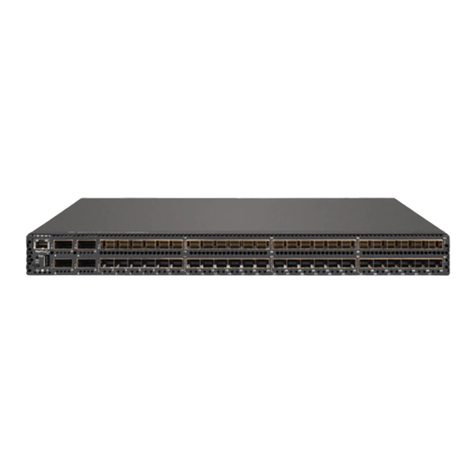
IBM
IBM RackSwitch G8264 Product guide
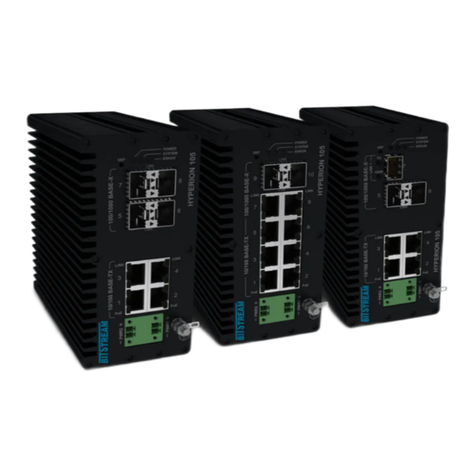
Bitstream
Bitstream HYPERION-105 Installation & Quick Start Manual

EUCHNER
EUCHNER CTP-I.-AS Unicode Series operating instructions

Alcatel
Alcatel OmniSwitch 6600 Family Configuration guide

Channel Vision
Channel Vision P-1205 user guide

H3C
H3C S12502X-AF quick start guide
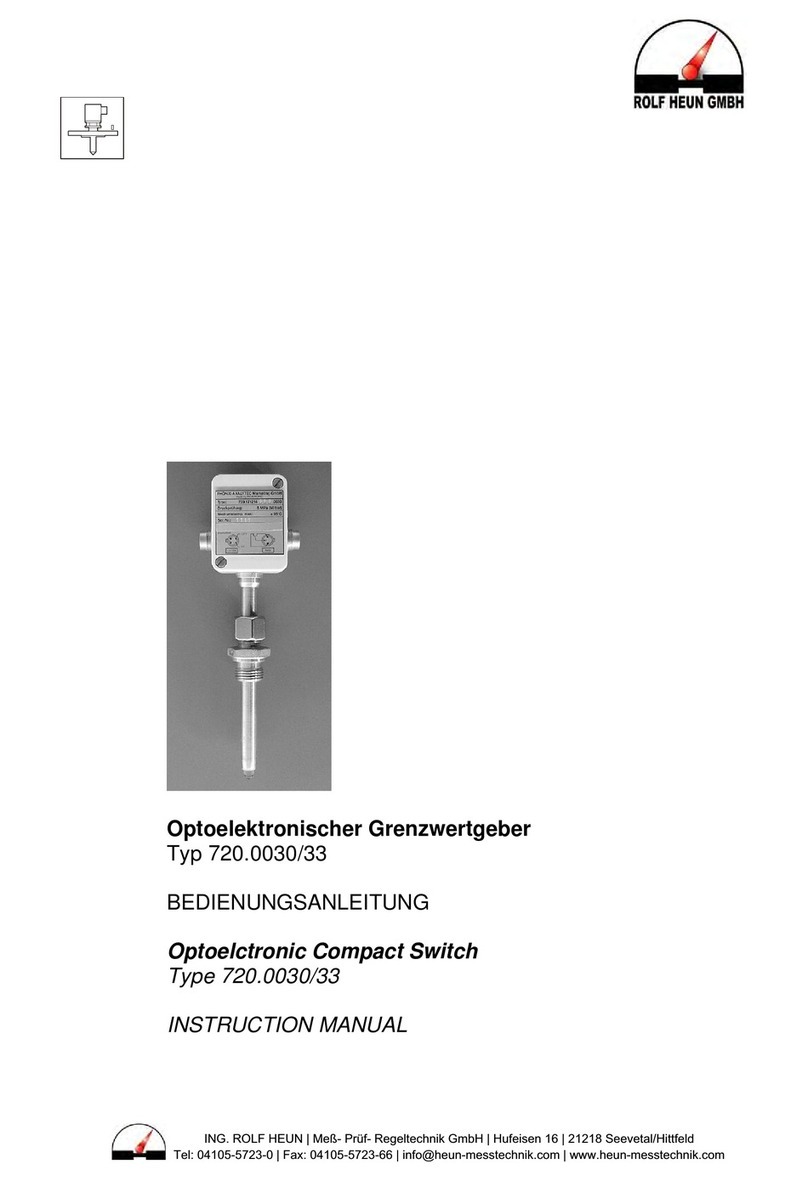
ROLF HEUN
ROLF HEUN 720.0030 instruction manual

HP
HP 3600 v2 Series Command reference
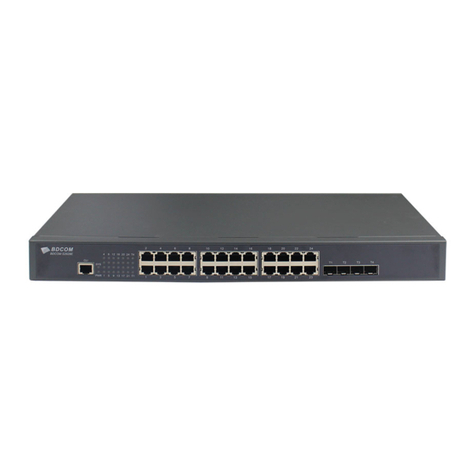
Bdcom
Bdcom S2928E Hardware installation manual
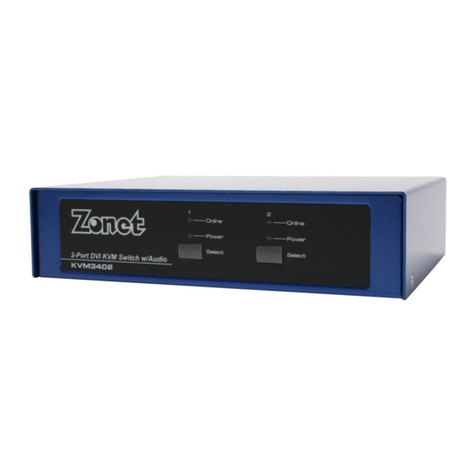
Zonet
Zonet KVM3402 installation guide
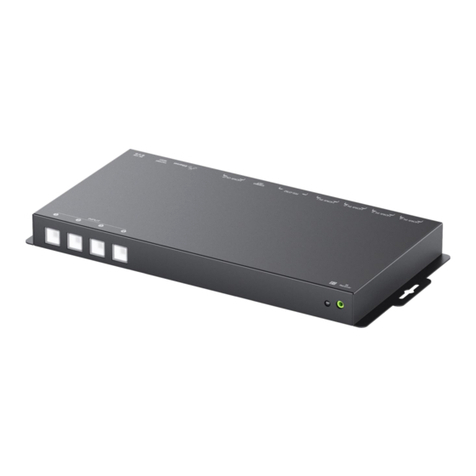
GoMax Electronics
GoMax Electronics SW-5004DE user manual
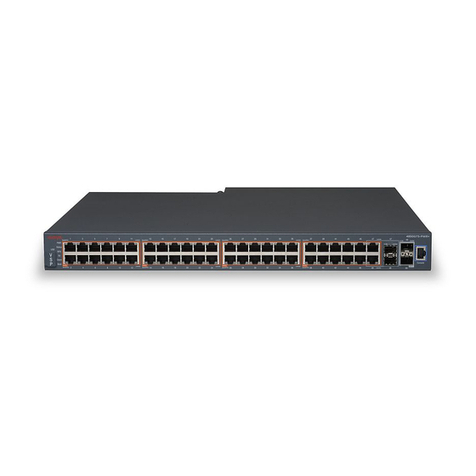
Extreme Networks
Extreme Networks ExtremeSwitching Virtual Services Platform 4850GTS... installation guide
